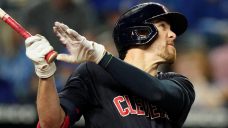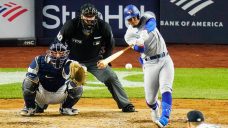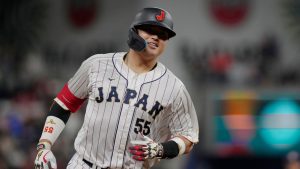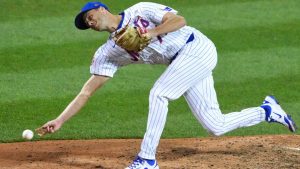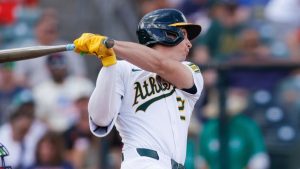NEW YORK — Towards the end of a challenging 2021 season, a challenging three years if he’s being honest, Danny Jansen began thinking about his game differently. About who he really is as a major-league hitter.
“I really believe that I’ve turned over a new leaf — just mentally within myself. I really feel like I've freed myself up,” the Toronto Blue Jays catcher says. “I’ve had a lot of struggle. And I’ve tried to learn through that struggle. I try to make as much as I can from it. Honestly, it’s just taken me a while to learn who I am as a hitter. And to stop trying to be somebody I’m not. Just having a strong approach, knowing who I am, believing in myself and my preparation — it’s helped me take a humongous step in the mental side of the game.”
Once the guy who faced adversity and wanted to add a dozen new drills to his routine to address the source of that struggle, Jansen’s embraced working smarter, not harder. Simplifying his approach; working on two or three things at a time rather than 10; trusting what he was doing in the batting cages would transfer onto the field if he gave it time; believing in himself, his preparation, his ability to hit the game’s best pitching and see results at the highest level.
That’s how Jansen came out of the offensive rut that saw him produce a.208/.297/.370 line over 626 plate appearances across his first three seasons as a big-leaguer, a production rate that stands in stark contrast to the .302/.396/.479 he hit over 784 plate appearances during his final two seasons in the minors.
It’s certainly not uncommon to see young players with strong offensive track records sputter as they encounter the planet’s best pitching for the first time, particularly catchers who are tasked with a few thousand ancillary responsibilities each day before they even get to think about hitting. And it’s worth noting that the 89 wRC+ Jansen’s produced as a big-leaguer is right in line with the 2021 average of all MLB catchers. Still, Jansen’s adjustment was severe. He’d had so much more success before against some pretty good pitching in the high levels of the minors. What happened?
His head was clouded, essentially. When Jansen was stepping into the box every night to face premium velocity and movement, he was thinking about being the hitter everyone says he should be, not the hitter he is. The guy who sprayed it to all fields in the minors but was now hitting everything to his pull side.
He was trying to remember mechanical adjustments that were meant to allow his swing to shoot more pitches the other way. He was looking over at three infielders standing on the left side of the diamond and trying to deny his own muscle memory, instead firing the movement patterns he’d spent all afternoon working on in the hopes of hitting the ball out of the range of those shifted defenders. And as more MLB teams embraced aggressive shifting, the worse it got. Here’s the defensive alignment Jansen has typically been looking at when he’s come to the plate:
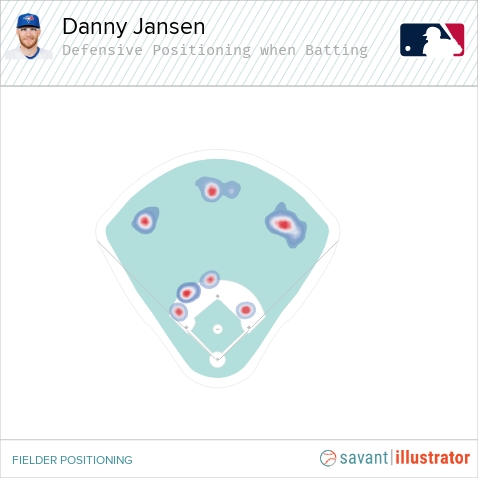
As a hitter, it gets in your head. Turns out it’s tough to be in the moment, thinking along with a pitcher and recognizing velocity and spin out of their hand, when your mind’s somewhere else. What Jansen needed to be thinking was to get his bat head out. To embrace pulling the ball, not to fight it. To let the swing that got him to the majors keep him in the majors. To worry less about mechanics, more about competing.
“When you've got a lot of different thoughts in your head about other crap, it's tough to hit. You already lost,” he says. “I just had to get out of my own way.”
He didn’t figure that out until late last summer, as he dove into his approach with Blue Jays developers while rehabbing a hamstring injury. Jansen arrived at that six-week injured list stint with a .176/.259/.336 line over his first 140 plate appearances of the 2021 season, frustrated, mentally worn down, and finally ready to do something about it. So, he did, deciding to abandon his efforts to improve a weakness, shooting balls the opposite way, and embrace a strength, pulling balls into the seats.
In his first game back, making his first MLB plate appearance in 40 days, Jansen let it rip:
And the results kept coming after that. He finished 2021 on a 19-for-59 tear with 14 extra-base hits — six of them homers — over 21 games. Then he spent a winter refining his new approach and shot a single the opposite way in his first plate appearance of 2022. Turned out, some of those opposite-field hits were coming naturally when he stopped trying so hard to make them happen.
He was seeing the ball better, too. It wasn’t getting on him as quickly as when he was trying to hold back and shoot balls to right field. He walked in his third plate appearance of the season and then yanked a homer into the left field seats during his fourth. In his next, he parked another one. The trip after that, a double to right. It was all working. It was all coming together. But then he swung aggressively — like he’s trying to — at a 2-0 fastball in his final plate appearance last Sunday and felt something grab in his left side. And two swings later, as he lifted a fly ball to left, he knew something was seriously wrong.
He'd strained his oblique, a rather important muscle for any MLB hitter trying to rotate their trunk and generate force beside home plate, but particularly catchers who spend the rest of their nights crouched behind it, manning the game’s most demanding defensive position. After an MRI revealed the severity of the strain, the club placed him on the 10-day IL and managed expectations by having Charlie Montoyo say Jansen would be out “for several weeks.”
That’s tough for Jansen to accept because the injury feels a little better with each passing day. A little less uncomfortable rolling around in bed; not quite as much twinge getting in and out of a car. But day-to-day activities are pretty different than major-league catching activities, of which Jansen won’t be doing any for some time. After hitting the injured list twice last season with right hamstring strains, he’s learned how problematic soft tissue injuries can be. And how important it is to thoroughly rest and recover before stressing the muscle again.
“It’s better to be safe than sorry at a time like this, right?” Jansen says. “Every part of me obviously wants to push through. That's always the hard part. But I definitely understand that it's early on and we have a very important season. This team, we're going to make a push. And just learning from the hamstrings last year, we want to get to a place where it won’t happen again. Where I can be part of the team later in the season. It’s hard to take right now. But I’ve just got to keep that bigger picture in mind.”
After visiting with a specialist Thursday, Jansen will be in the dugout with his teammates in Toronto Friday, something that’s important to him as he strives to continue contributing any way he can. Inactive for games in New York this week, Jansen was highly active in the lead up to them, participating in his club’s daily pitchers-and-catchers meetings, offering any insights he could.
He worked closely with Tyler Heineman, getting him up to speed on the many adjustments Yusei Kikuchi was attempting to establish in his Blue Jays debut, and he’s spent time in bullpens with Zack Collins, as the recently-acquired backstop catches side sessions from Blue Jays starters and relievers, undergoing a crash course in how the club wants its catchers setting up, receiving, and game-calling.
Alejandro Kirk knows Toronto’s staff well and is positioned to receive the bulk of playing time being the plate in Jansen’s absence. But he obviously can’t catch every day. Especially as the Blue Jays play 20 games in 20 days starting Monday — the maximum stretch of consecutive days a team can play without an off-day under MLB’s CBA. Heineman and Collins are going to get their opportunities. Which is what makes Jansen’s continued presence and involvement with the team so crucial.
“Jano’s been great for those guys to lean on,” says Blue Jays bench coach John Schneider. “Obviously, the timing really sucks for him. Over the past three years, he’s had to really grind to get to where he got offensively last year. And then to see him carry it over this season was so awesome. We were really excited for him. I know he’s going to be cautious with this so it doesn’t become a lingering thing. But we’re really looking forward to him coming back.”
Yeah, tell Jansen about it. After years spent withstanding adversity and searching for himself as a big-league hitter, he finally finds something that works for him only to be derailed by a uniquely compromising injury for the position he plays. That’s tough to swallow. But if Jansen’s learned anything through his considerable struggles since making his MLB debut four years ago, it’s that the mind’s a powerful thing. And the better he can harness his, the easier things come.
“Honestly, I can’t say enough how huge the mental progress I’ve made is. I really feel like I'm in a great space. And I'm really happy and proud of how I got there. I know who I am. I know why I’m here. And I think when you know those things and truly understand what your strengths are, it frees you up,” Jansen says. “It's all mental, man. That's what they say about baseball, right? Especially hitting. So, sure, I’ve had a lot of struggles. But, who knows, maybe I wouldn't be where I am mentally now if not for it. So, I’ll take this adversity head on. And come out of it better.”

